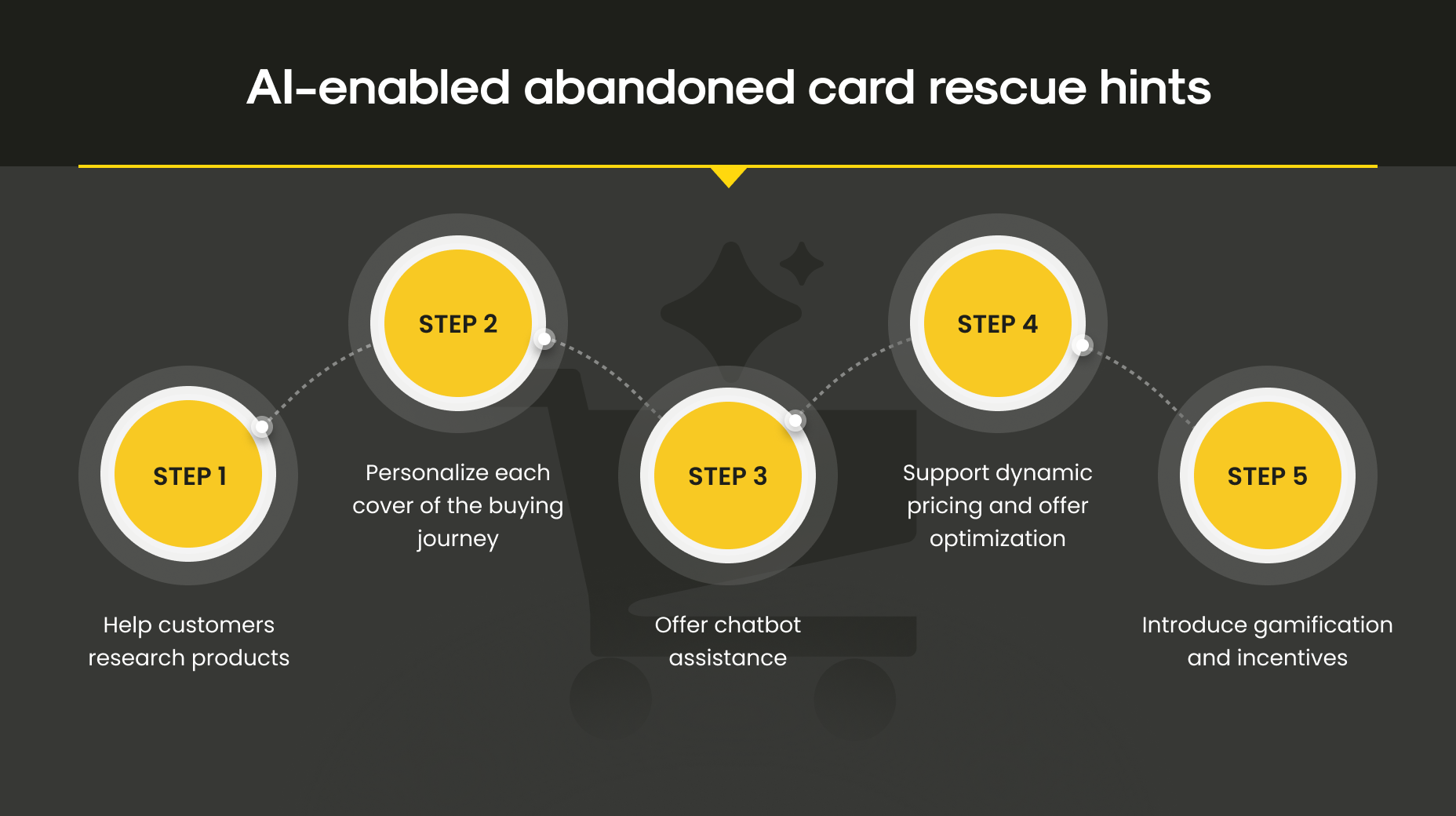In online retail, the checkout page should be the decisive moment. The place where product discovery, customer persuasion, and brand trust all culminate in a successful transaction. But instead of “order confirmed,” retailers often hear nothing. You got it right: the customer vanishes, and the cart remains full but unpaid for.
Every abandoned cart is a story of unrealized potential: marketing dollars spent to bring the shopper in, merchandising and UX working to convert them, only for the momentum to collapse at the last step. The scale of the problem is both daunting and full of potential: it drains revenue today, yet even a small improvement could unlock a significant boost in sales. In this article, you’ll explore:
- Why nearly 70% of online shopping carts are left unpaid, and why fixing even a fraction of that loss can dramatically boost revenue.
- The main reasons behind abandoned carts.
- Why “after-the-fact” recovery has limits and why abandoned cart emails and retargeting campaigns often arrive too late.
- How AI chatbots change the game.
- The psychology of perfect timing and why intervening at the moment of doubt yields better conversion rates.
- How AI taps into browsing history, cart contents, and loyalty data to make offers that feel relevant, not spammy.
- Best practices for AI engagement.
Why shoppers abandon their carts
Nowadays, it’s one of the most persistent challenges in ecommerce. Global cart abandonment rates hover around 70%, meaning that seven out of ten shoppers who demonstrate a clear intention to buy, don’t make it through the finish line. For retailers, that’s a revenue leak so large it’s practically a flood. Understanding the “why” behind abandonment is key before trying to solve it. The most common reasons include:
- Unexpected costs at checkout. Shipping fees, taxes, handling charges suddenly appear, creating sticker shock.
- Complicated or lengthy checkout flows. Too many steps, too many form fields, or required account creation push shoppers away.
- Concerns about trust. Unclear return policies, ambiguous delivery timelines, or lack of secure payment signals can erode confidence.
- Distraction and delay. Especially on mobile, where shoppers may be browsing in line at a coffee shop or during a commute, interruptions are inevitable.
- Technical issues. Failed payment attempts, slow page loading, or glitches during checkout.
As of 2025, mobile shopping in particular magnifies these issues. On smaller screens, minor friction feels bigger, and attention spans are shorter. Research consistently shows that mobile abandonment rates are even higher than desktop.
The limitations of “after the fact” recovery
For years, the ecommerce playbook for dealing with abandonment has been reactive. Abandoned cart emails, retargeting ads, and follow-up SMS campaigns aim to lure shoppers back after they’ve left.
While these tactics can work, they rely on the customer remaining interested hours ( or even days) later. By the time that reminder email arrives, the initial emotional drive to purchase has usually faded. The shopper may have bought from a competitor, decided they didn’t need the item, or simply forgotten they wanted it at all. In other words, these methods are working uphill against time and distraction. The most effective recovery happens before the cart is abandoned, not after.
AI-powered real-time engagement changes the game
That’s where AI comes in. Smart AI chatbots and conversational agents give retailers the ability to step in at the moment of hesitation: when the sale is still alive, but at risk.
By monitoring customer behavior in real time, AI systems can detect key abandonment signals:
- A shopper lingering too long on a payment page
- The mouse moving toward the browser’s close button
- A sudden pause after shipping costs appear
- An error in the payment process

AI-enabled abandoned cart hints
Instead of silently watching the customer exit, the AI can act immediately. It might:
- Offer a free shipping incentive if that’s the likely barrier
- Provide a quick answer about delivery timelines
- Suggest an alternative payment method
- Remind the shopper of loyalty points or a discount code they have available
This is proactive engagement, not reactive chasing. It’s the difference between letting a customer walk out of a store with full arms and catching them at the door to resolve their concern.
Timing is everything
The psychology behind this is straightforward: shoppers are more likely to buy when the desire to purchase is fresh. The longer the gap between decision and action, the more opportunities for doubt, distraction, and deferral to creep in.
AI’s strength is that it can respond in milliseconds, meeting the shopper while they’re still mentally “in the store.” It’s the online equivalent of a helpful sales associate stepping in at just the right moment to answer a question or remove a barrier.
Retailers implementing real-time AI interventions often see measurable gains quickly. Depending on their starting point and how personalized the engagement is, abandonment rates can drop by 15% to 40%. In high-volume ecommerce operations, that’s not just incremental, it’s transformative.
Personalization at scale
Not all interventions are created equal, if you will. A generic “Need help?” popup might be ignored or even dismissed as annoying. The real power of AI engagement lies in personalization, making the outreach relevant and specific to the shopper’s situation.
Because AI chatbots can integrate with a retailer’s CRM, e-commerce platform, and product catalog, they have context:
- What’s in the customer’s cart
- Whether they’ve shopped here before
- What products they’ve viewed this session
- Their past purchase history or loyalty tier
This allows for targeted offers:
- A first-time customer hesitating at checkout might get a small discount code as a welcome.
- A returning customer could be reminded of loyalty rewards they can apply.
- A high-value shopper could be offered complimentary expedited shipping.
These touches make the interaction feel like a service, not a sales push.
From lost sale to recovered sale
Picture this scenario: a customer adds three items to their cart, reaches the shipping page, and sees a delivery fee that feels too high. Naturally, they hover over the tab close button and leave. Hours later, they get an abandoned cart email, but by then they’ve already moved on.
With AI engagement, however, the chatbot recognizes the hesitation. It appears with a friendly message: “We’d love to cover your shipping if you complete your order now. Want me to apply for the free shipping discount?”
The barrier is removed instantly. The shopper accepts, pays, and leaves happy, while the retailer keeps the sale. Multiply that scenario by hundreds or thousands of monthly shoppers, and the recovered revenue becomes significant.
Improving customer experience, not just conversion
While the financial upside of reducing cart abandonment is obvious, there’s another benefit that’s often overlooked: improving the customer experience at the moment it matters most.
By resolving issues in real time, retailers show customers that their concerns are seen and addressed immediately. That can translate into higher satisfaction, more repeat purchases, and stronger brand loyalty.
It’s also worth noting that not every intervention needs to include a discount. In many cases, customers simply need reassurance or clarity. For example, confirming that returns are free or that an item will arrive before a specific date.
Building the right AI engagement strategy
For retailers considering AI-powered cart recovery, success depends on thoughtful implementation. A few best practices include:
- Use clear behavioral triggers. Don’t bombard every visitor, target genuine hesitation signals.
- Match tone to brand voice. The chatbot should feel like a natural extension of your brand, not a generic AI agent.
- Offer a mix of incentives and information. Not every engagement should be a price drop and service-based value works too.
- Optimize for mobile. Engagement windows should be mobile-friendly and unobtrusive.
- Enable seamless escalation. If the chatbot can’t resolve the issue in two or three exchanges, it should hand it off to a live agent.
Measuring success
Like any ecommerce initiative, AI engagement should be measured against clear KPIs. These might include:
- Percentage reduction in cart abandonment rate
- Chat-to-order conversion rate
- Average order value from recovered carts
- Incremental revenue versus cost of the AI platform
- Customer satisfaction scores after chatbot interaction
Continuous testing and optimization (A/B testing messages, timing, and offers) ensures the strategy evolves alongside customer behavior. Here are the key advantages of AI chatbots for online retail:
24/7 customer support
AI chatbots don’t clock out. They’re ready to respond instantly at any hour, ensuring shoppers always get answers when they need them, which keeps satisfaction high and reduces strain on human support teams.
Streamlined operations
By taking over routine tasks (from providing shipping updates to answering FAQs) chatbots free up live agents to tackle more nuanced issues. This increases efficiency while lowering service costs.
Tailored shopping experiences
Powered by data and machine learning, chatbots can interpret shopper behavior and deliver spot-on product recommendations, targeted offers, and personalized messaging that boost loyalty and sales.
Unified omnichannel service
Integrated across your website, social platforms, and messaging apps, AI chatbots create a seamless customer journey, no matter where the conversation begins or ends.
Cost-effective scalability
As your store grows, chatbots handle rising interaction volumes without sacrificing quality or driving up staffing expenses, making it easy to serve more customers at the same high standard.
The bigger picture: retention in an expensive acquisition world
With acquisition costs rising and ad competition fierce, every visitor is hard-won. Letting them slip away at checkout without a fight is like spending money to fill a bucket with holes in the bottom.
Fortunately, AI engagement plugs those holes. Okay, not perfectly, but effectively enough to turn meaningful amounts of leakage back into profit. And unlike purely discount-based recovery strategies, AI enables targeted, intelligent interventions that protect margins while increasing conversions.
How Mitrix can help
At Mitrix, we deliver AI/ML and generative AI development services that help companies:
- Design intelligent bots that understand supply chain workflows
- Integrate chatbots with tracking systems, CRMs, ERPs, and TMSs
- Build multilingual, multi-channel support agents (WhatsApp, web, SMS)
- Monitor performance and apply machine learning for ongoing improvements
At Mitrix, we build AI agents designed around your needs, whether you’re looking to boost customer support, unlock insights from data, or streamline operations. Let’s create a robust AI agent tailored to transform your business!
Customer support agent
Delivers 24/7 customer assistance, resolves inquiries efficiently, addresses issues, and enhances overall customer satisfaction.
Healthcare assistant
Performs preliminary symptom assessments, organizes patient records, and provides accurate medical information.
Financial advisor
Delivers tailored investment advice, monitors market trends, and creates personalized financial plans.
Sales agent
Identifies and qualifies leads, streamlines sales processes, and drives growth by strengthening the sales pipeline.
Data analysis agent
Processes and interprets large datasets, delivers actionable real-time insights, and aids in strategic decision-making.
Virtual assistant
Organizes schedules, manages tasks, and provides timely reminders to enhance productivity.
Whether you’re coordinating international freight, managing warehouse logistics, or optimizing last-mile delivery, Mitrix can help build the chatbot system to match. Contact us today to discuss your virtual assistant!
Summing up
Let’s be real: cart abandonment will never disappear entirely. Some customers will always change their minds, get distracted, or decide against a purchase. But with smart AI engagement, retailers can dramatically reduce the number of “almost” sales that vanish without a trace.
By acting at the right moment, offering relevant help or incentives, and personalizing the interaction at scale, AI chatbots turn hesitation into completion. They don’t just recover lost revenue: they create better buying experiences, stronger customer relationships, and a smoother path from browsing to buying. In ecommerce, where every checkout counts, that’s not just a win, it’s a competitive advantage.


